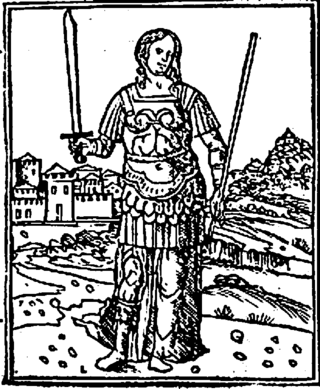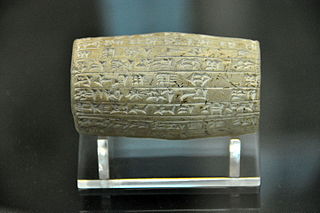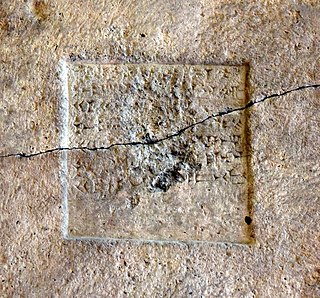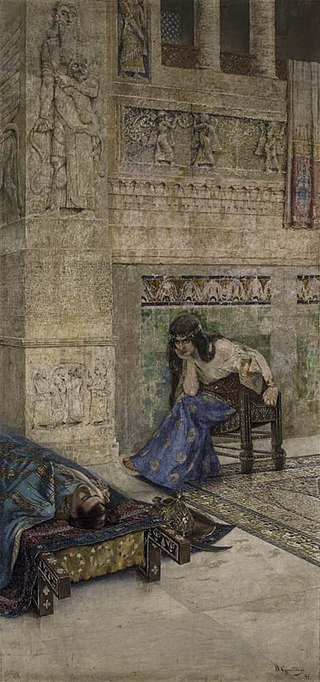
Trier, formerly known in English as Trèves and Triers, is a city on the banks of the Moselle in Germany. It lies in a valley between low vine-covered hills of red sandstone in the west of the state of Rhineland-Palatinate, near the border with Luxembourg and within the important Moselle wine region.
The 8th century BCE started the first day of 800 BC and ended the last day of 701 BC. The 8th century BC is a period of great change for several historically significant civilizations. In Egypt, the 23rd and 24th dynasties lead to rule from Nubia in the 25th Dynasty. The Neo-Assyrian Empire reaches the peak of its power, conquering the Kingdom of Israel as well as nearby countries.

Babylonia was an ancient Akkadian-speaking state and cultural area based in the city of Babylon in central-southern Mesopotamia. It emerged as an Amorite-ruled state c. 1894 BC. During the reign of Hammurabi and afterwards, Babylonia was called "the country of Akkad", a deliberate archaism in reference to the previous glory of the Akkadian Empire. It was often involved in rivalry with the older state of Assyria to the north and Elam to the east in Ancient Iran. Babylonia briefly became the major power in the region after Hammurabi created a short-lived empire, succeeding the earlier Akkadian Empire, Third Dynasty of Ur, and Old Assyrian Empire. The Babylonian Empire rapidly fell apart after the death of Hammurabi and reverted to a small kingdom.
Ninus, according to Greek historians writing in the Hellenistic period and later, was the founder of Nineveh, ancient capital of Assyria. The figure or figures with which he corresponds in Assyrian records is uncertain; an association or identification with Ninurta has been proposed. An identification with Shamshi-Adad I, Shamshi-Adad V, and/or a conflation of the two have also been suggested.

Semiramis was the semi-legendary Lydian-Babylonian wife of Onnes and Ninus, who succeeded the latter to the throne of Assyria, according to Movses Khorenatsi. Legends narrated by Diodorus Siculus, who drew primarily from the works of Ctesias of Cnidus, describe her and her relationships to Onnes and King Ninus.

Nimrod is a biblical figure mentioned in the Book of Genesis and Books of Chronicles. The son of Cush and therefore a great-grandson of Noah, Nimrod was described as a king in the land of Shinar (Mesopotamia). The Bible states that he was "a mighty hunter before the Lord [and] ... began to be mighty in the earth". Later extra-biblical traditions identified Nimrod as the ruler who commissioned the construction of the Tower of Babel, which led to his reputation as a king who was rebellious against God.

Nabopolassar was the founder and first king of the Neo-Babylonian Empire, ruling from his coronation as king of Babylon in 626 BC to his death in 605 BC. Though initially only aimed at restoring and securing the independence of Babylonia, Nabopolassar's uprising against the Neo-Assyrian Empire, which had ruled Babylonia for more than a century, eventually led to the complete destruction of the Assyrian Empire and the rise of the Neo-Babylonian Empire in its place.

Ashurbanipal was the king of the Neo-Assyrian Empire from 669 BCE to his death in 631. He is generally remembered as the last great king of Assyria. Inheriting the throne as the favored heir of his father Esarhaddon, Ashurbanipal's 38-year reign was among the longest of any Assyrian king. Though sometimes regarded as the apogee of ancient Assyria, his reign also marked the last time Assyrian armies waged war throughout the ancient Near East and the beginning of the end of Assyrian dominion over the region.

Aššur (; Sumerian: 𒀭𒊹𒆠 AN.ŠAR2KI, Assyrian cuneiform: Aš-šurKI, "City of God Aššur"; Syriac: ܐܫܘܪ Āšūr; Old Persian 𐎠𐎰𐎢𐎼Aθur, Persian: آشور: Āšūr; Hebrew: אַשּׁוּר, ʾAššūr, Arabic: اشور), also known as Ashur and Qal'at Sherqat, was the capital of the Old Assyrian city-state (2025–1364 BC), the Middle Assyrian Empire (1363–912 BC), and for a time, of the Neo-Assyrian Empire (911–609 BC). The remains of the city lie on the western bank of the Tigris River, north of the confluence with its tributary, the Little Zab, in what is now Iraq, more precisely in the al-Shirqat District of the Saladin Governorate.

Belus or Belos in classical Greek or classical Latin texts in an Assyrian context refers to one or another purportedly ancient and historically mythical Assyrian king, such king in part at least a euhemerization of the Babylonian god Bel Marduk.

The Two Babylons, subtitled Romanism and its Origins, is a book that started out as a religious pamphlet published in 1853 by the Presbyterian Free Church of Scotland theologian Alexander Hislop (1807–65).

Adad-nirari III was a King of Assyria from 811 to 783 BC. Note that this assumes that the longer version of the Assyrian Eponym List, which has an additional eponym for Adad-nirari III, is the correct one. For the shorter eponym list the ascension year would be 810 BC.

Shammuramat, also known as Sammuramat or Shamiram, was a powerful queen of the Neo-Assyrian Empire. Beginning her career as the primary consort of the king Shamshi-Adad V, Shammuramat reached an unusually prominent position in the reign of her son Adad-nirari III. Though there is dispute in regard to Shammuramat's formal status and position, and if she should be considered a co-regent, it is clear that she was among the most powerful and influential women of the ancient Near East; she is the only known Assyrian queen to have retained her status as queen after the death of her husband and the only known ancient Assyrian woman to have partaken in, and perhaps even led, a military campaign.

Ara the Handsome is a semi-legendary Armenian hero and king. Ara is notable in Armenian literature for the popular legend in which he was so handsome that the Assyrian queen Semiramis waged war against Armenia to capture him and bring him back to her, alive.

The Neo-Assyrian Empire was the fourth and penultimate stage of ancient Assyrian history and the final and greatest phase of Assyria as an independent state. Beginning with the accession of Adad-nirari II in 911 BC, the Neo-Assyrian Empire grew to dominate the ancient Near East throughout much of the 8th and 7th centuries BC, becoming the largest empire in history up to that point. Because of its geopolitical dominance and ideology based in world domination, the Neo-Assyrian Empire is by many researchers regarded to have been the first world empire in history. At its height, the empire was the strongest military power in the world and ruled over all of Mesopotamia, the Levant and Egypt, as well as portions of Anatolia, Arabia and modern-day Iran and Armenia.
Edward Hine originated the notion, still current in Anglo-Israelism and some strains of U.S. Christian fundamentalism, that modern Germans are partly descended from the ancient Assyrians. In this belief system, the British are the sole descendants of the Ten Lost Tribes of Israel, in opposition to other Anglo-Israelism advocates who included Germans in the lost tribes. Hine's view, instead, is that the German are descendants of the Assyrians. Hine's view, thus, considers the British as the Kingdom of Israel and the Germans as the Neo-Assyrian Empire. Those who believe this hold many pseudohistorical views in an attempt to back this view. This primordialist idea, like the Anglo-Israelism out of which it emerged, has no foundation in modern history, linguistics, or genetics.

Io Semiramide is a 1963 film about Semiramis, a queen of the Neo-Assyrian Empire. It was directed by Primo Zeglio. The legends are in part based on the historical Shammuramat, queen consort of Shamshi-Adad V and regent for her son Adad-nirari III.

Naqiʾa or Naqia (Akkadian: Naqīʾa, also known as Zakutu, was a wife of the Assyrian king Sennacherib and the mother of his son and successor Esarhaddon. Naqiʾa is the best documented woman in the history of the Neo-Assyrian Empire and she reached an unprecedented level of prominence and public visibility; she was perhaps the most influential woman in Assyrian history. She is one of the few ancient Assyrian women to be depicted in artwork, to commission her own building projects, and to be granted laudatory epithets in letters by courtiers. She is also the only known ancient Assyrian figure other than kings to write and issue a treaty.

Sargon II ruled the Neo-Assyrian Empire from 722 to 705 BC as one of its most successful kings. In his final military campaign, Sargon was killed in battle in the south-eastern Anatolian region Tabal and the Assyrian army was unable to retrieve his body, which meant that he could not undergo the traditional royal Assyrian burial. In ancient Mesopotamia, not being buried was believed to condemn the dead to becoming a hungry and restless ghost for eternity. As a result, the Assyrians believed that Sargon must have committed some grave sin in order to suffer this fate. His son and successor Sennacherib, convinced of Sargon's sin, consequently spent much effort to distance himself from his father and to rid the empire from his work and imagery. Sennacherib's efforts led to Sargon only rarely being mentioned in later texts. When modern Assyriology took form in Western Europe in the 18th century, historians mainly followed the writings of classical Greco-Roman authors and the descriptions of Assyria in the Hebrew Bible for information. Given that Sargon is barely mentioned in either, he was consequently forgotten, the then prevalent historical reconstructions placing Sennacherib as the direct successor of Sargon's predecessor Shalmaneser V and identifying Sargon as an alternate name for one of the more well-known kings.
















